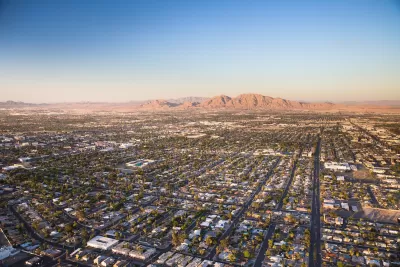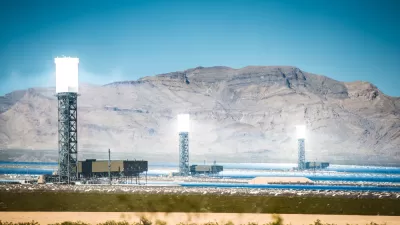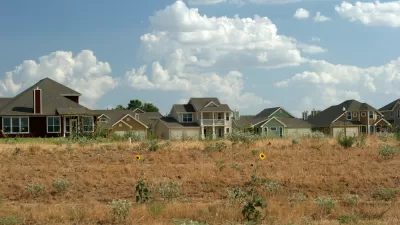Having sprawled for the past few decades, the Las Vegas region is bumping up against undevelopable federal lands. Those limits give it the chance to consider a denser, more urban future.

“At 5,046 residents per square mile, the City of Las Vegas is not exactly Hoboken, but it’s denser than you'd imagine,” writes Josh Stephens in the California Planning & Development Report. “It has plenty of small houses on small lots (making it relatively inexpensive on a per-unit basis), and it has its share of small apartment buildings. Many residents commute to one of the greatest concentrations of employment (especially blue-collar employment) in the country: the Las Vegas Strip. So, there are gravitational forces keeping residents in the city.”
“To its credit, Las Vegas wants to grow. It wants none of the slow-growth paralysis that has hobbled too many parts of California. Unfortunately, Lombardo's plea indicates that he wants Las Vegas to continue to sprawl, presumably by continuing to build inexpensive single-family homes, parking-heavy apartment complexes, and whatever inconsequential commercial developments are needed to keep suburbanites fed, fit, and fueled up.”
“Gov. Lombardo has said that provision of housing 'begins with eliminating governmental barriers to development.' Sure, but it doesn't have to be the federal government that does the eliminating.”
“Back in 1972, architects Robert Venturi, Denise Scott Brown, and Steve Izenour famously celebrated Las Vegas’s design sensibilities. They reveled in the superficiality of signage and simulacra. Now, Las Vegas — not the Strip, but the actual city — faces the opportunity to get real.”
FULL STORY: Las Vegas' Opportunity to Learn from California

Trump Administration Could Effectively End Housing Voucher Program
Federal officials are eyeing major cuts to the Section 8 program that helps millions of low-income households pay rent.

Planetizen Federal Action Tracker
A weekly monitor of how Trump’s orders and actions are impacting planners and planning in America.

Ken Jennings Launches Transit Web Series
The Jeopardy champ wants you to ride public transit.

Washington Legislature Passes Rent Increase Cap
A bill that caps rent increases at 7 percent plus inflation is headed to the governor’s desk.

From Planning to Action: How LA County Is Rethinking Climate Resilience
Chief Sustainability Officer Rita Kampalath outlines the County’s shift from planning to implementation in its climate resilience efforts, emphasizing cross-departmental coordination, updated recovery strategies, and the need for flexible funding.

New Mexico Aging Department Commits to Helping Seniors Age ‘In Place’ and ‘Autonomously’ in New Draft Plan
As New Mexico’s population of seniors continues to grow, the state’s aging department is proposing expanded initiatives to help seniors maintain their autonomy while also supporting family caregivers.
Urban Design for Planners 1: Software Tools
This six-course series explores essential urban design concepts using open source software and equips planners with the tools they need to participate fully in the urban design process.
Planning for Universal Design
Learn the tools for implementing Universal Design in planning regulations.
Heyer Gruel & Associates PA
Ada County Highway District
Institute for Housing and Urban Development Studies (IHS)
City of Grandview
Harvard GSD Executive Education
Toledo-Lucas County Plan Commissions
Salt Lake City
NYU Wagner Graduate School of Public Service





























